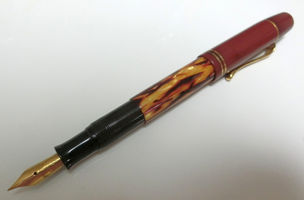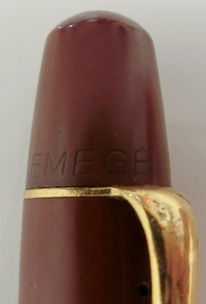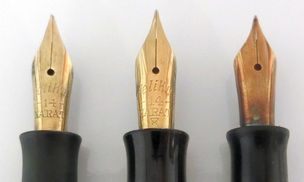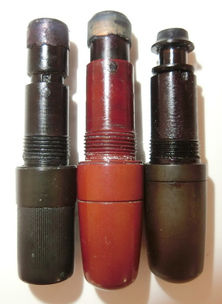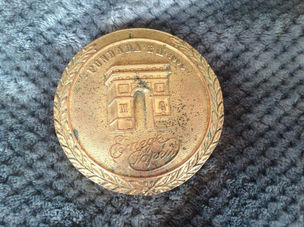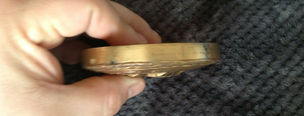top of page
Pelikan Magnum (ca.1935) - the first year version
Green indicates the points that differ from Pelikan 100 (ca.1935).
Cap top; material: ebonite, shape: conical, inclined cap top edge, logo: old four chicks logo on the top and “Pelikan Patent EMEGÊ” on the lateral side.
Cap tube; material: ebonite, shape: 2 cap holes (one hole facing each other), two narrow bands, grooved at the level of vent holes around the inner wall.
Clip; shape: gold plated drop clip.
Nib; material: 14 ct gold, shape: round vent hole, logo:
Pelikan
14 KARAT
▽
Feed; material: ebonite, shape: slanted tail, three lamellae with the recess⁽¹⁾.
Nib socket; material: ebonite⁽¹⁾.
Grip section; material: ebonite, shape; inclined top edge, slightly tapered, step near the thread.
Barrel; material: transparent green celluloid without brass ring, coated with white paint.
Sleeve; material: celluloid.
Filling system; material: ebonite with cork seal, shape: conical, smooth turning knob with arrow.
Dimensions;
This is the largest pen Günter Wagner made in the 1930s.
On December 31, 1935, Pelikan Magnum appeared for the first time as “Portugiesische Aufmachung (Portuguese appearance)” in the delivery document from Günter Wagner⁽²⁾. According to the document, Monteiro Guimarães Filho Lda, the Günter Wagner’s licensed Portuguese distributor, ordered 1600 fountain pens on October 16, 1935. The pens were in brown color, and the cap top had Pelikan logo and the markings “Pelikan-Emegê (Emegê in block letter)” (Fig.4). In Portuguese, the initials of Monteiro Guimarães was EME (M) and GÊ (G), phonetically. Those markings were probably made at the Günter Wagner factory because it wasn't easy to make the imprint around the cap top. Reportedly, this was done as the company wanted to give full warranty to and repair only the pens they imported and sold. In the following orders, "Emege (in cursive letter)" markings were made either in the cap or the sleeve (click). In 1935-36, there were a good number of them made, most of which were sold in Portugal. But, the pen is not found in the official price lists. The descriptions above are mostly based on the article by Vasco Pisco. Please refer to his article for further information (click).
As Vasco Pisco have already made a comprehensive research, Pelikan Magnum is based on the Pelikan 100. At the same time, the pen is the prototype or the predecessor of Pelikan 100N (click). To trace the "evolution" of Pelikan fountain pens, I myself compared Pelikan Magnum (ca.1935) with Pelikan 100 from the same year (ca.1935) and the first year Pelikan 100N (ca.1937).
-
Dimension; The length of the grip section and ink window are the same through the three models. Pelikan Magnum has the longest sleeve and filling system (Fig.5, 6). Pelikan Magnum is 9 mm longer and 1 mm thicker than 100. Pelikan 100N is 6 mm shorter and 0.5 mm thinner than Magnum. So, Magnum looks more like 100N than 100 in dimension.
-
Shape; All the cap tops are conical, among which Magnum has the most cone-like cap top. In the model Magnum, the turning knob became conical. As a result, the shape became more streamlined. In the model Magnum, a step was added to the grip section⁽³⁾. So, Magnum looks more like 100N than 100 in shape.
-
Nib; The nib of Pelikan 100 (ca.1935) and Pelikan Magnum (ca.1935) have the similar “Pelikan” imprint that was revised in 1934. The magnum Nib has "reversed triangle", which seems to be manufacturers mark (Fig.1-1) . The same "reversed triangle" is seen on the nib of short cap top Pelikan 100 (Fig.15). Pelikan 100N (ca.1937) nib has “Pelikan” imprint that was revised in 1937. The shape is different from other two nibs. So, Magnum looks more like 100 than 100N as for the nib.
-
Feed; When Pelikan 100N was introduced in 1937, the feed that was similar to that of Magnum in size and construction was used. So, Magnum looks more like 100N than 100 as for the feed (Fig.1-2).
-
Filling system; Many constructional changes were made in the model 100N. 1) the cone narrowed, 2) the notch was made on the piston guide for the piston rod stopper, 3) the screw-in type cork seal stopper was adopted, 4) an arrow in the turning knob was abolished (Fig.8), 5) The thread on the spindle narrowed (Fig.9). So, Magnum looks more like 100 than 100N as for the filling system.
So, Pelikan Magnum was the transitional model from 100 to 100N. I'm not sure if Pelikan Magnum was the pilot model for 100N.
Lastly, I'd like to comment on the "tortoiseshell" sleeve and the barrel. One day, when I twisted the turning knob while holding the sleeve, the sleeve came off accidentally (not intentionally) and the white layer appeared under the sleeve. The barrel was coated with the white layer (Fig.10). My Pelikan 100 and Pelikan 100N have the reinforcing ring brass on the barrel but not my Pelikan Magnum⁽⁴⁾. At first, I didn't know why the adhesive or foundation was white. But, this site explained the reason why for me. According the site, for the color sleeve (brown?) of model 100/100N⁽⁵⁾, the barrels were coated with white paint, so that base barrel color would not show through the sleeve. As you see in Fig.11, the the brown sleeve is transparent, almost intact and no color fading. But, without the foundation, it looks dark brown due to the darkened barrel (Fig.12) (originally, the barrel should be green)(Fig.13). Thanks to the foundation, the sleeve looks still light "tortoiseshell" just as it was made. When the white foundation gets degraded over time or is removed for repair, the sleeve color looks darkened or "faded", even if the sleeve itself is not (Fig.14 bottom)⁽⁵⁾. As in my 101N with the reinforcing ring, the difference of the color tone is clearer (Fig.14 middle). Pelikan M101N Tortoiseshell Brown is another example how the pen looks without the foundation on the barrel. The green barrel shows through the sleeve, making the pen further greenish. The white foundation was the "arcana" that Günter Wagner hid under the sleeve.
Note;⁽¹⁾The nib unit can't be removed. So, I have no further information.
⁽²⁾While on the market, the pen were not called "Pelikan Magnum". The pen had long been regarded as variant of model 100N (Pelikan-guide.com). In the German fountain pen book published in 1995, Pelikan Magnum was called "100N 1937 Schildpatt (tortoiseshell)" (in the center of the middle row) (click). However, recent research by Vasco Pisco indicates that the pen was produced alongside with model 100 and before model 100N. "Magnum is a Pelikan pen model by itself and not a Pelikan 100N variant"(Vasco Pisco) (click). I'm wondering who and when named the pen "Magnum".
⁽³⁾What was the step for? Model 100N was also equipped with the step.
⁽⁴⁾As in Vasco's pen, some Magnum has the the reinforcing ring.
⁽⁵⁾I can't specify what model of 100/100N had the white foundation and what model not.
bottom of page


